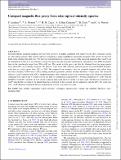Files in this item
Unsigned magnetic flux proxy from solar optical intensity spectra
Item metadata
| dc.contributor.author | Lienhard, F | |
| dc.contributor.author | Mortier, A | |
| dc.contributor.author | Cegla, H M | |
| dc.contributor.author | Cameron, A Collier | |
| dc.contributor.author | Klein, B | |
| dc.contributor.author | Watson, C A | |
| dc.date.accessioned | 2023-05-19T16:30:04Z | |
| dc.date.available | 2023-05-19T16:30:04Z | |
| dc.date.issued | 2023-07-01 | |
| dc.identifier | 286016688 | |
| dc.identifier | 66cccf4c-a876-4038-a1ea-719b966f4f90 | |
| dc.identifier | 85161566975 | |
| dc.identifier.citation | Lienhard , F , Mortier , A , Cegla , H M , Cameron , A C , Klein , B & Watson , C A 2023 , ' Unsigned magnetic flux proxy from solar optical intensity spectra ' , Monthly Notices of the Royal Astronomical Society , vol. 522 , no. 4 , pp. 5862-5878 . https://doi.org/10.1093/mnras/stad1343 | en |
| dc.identifier.issn | 0035-8711 | |
| dc.identifier.other | Jisc: 1082538 | |
| dc.identifier.other | ORCID: /0000-0002-8863-7828/work/135454888 | |
| dc.identifier.uri | https://hdl.handle.net/10023/27656 | |
| dc.description | Funding: FL gratefully acknowledges a scholarship from the Fondation Zdenek et Michaela Bakala AM acknowledges support from the senior Kavli Institute Fellowships. ACC acknowledges support from STFC consolidated grant numbers ST/R000824/1 and ST/V000861/1, and UKSA grant number ST/R003203/1. BK acknowledges funding from the European Research Council under the European Union’s Horizon 2020 research and innovation programme (grant agreement No 865624, GPRV). | en |
| dc.description.abstract | The photospheric unsigned magnetic flux has been shown to be highly correlated with radial velocity (RV) variations caused by solar surface activity. This activity indicator is therefore a prime candidate to unlock the potential of RV surveys to discover Earth twins orbiting Sun-like stars. We show for the first time how a precise proxy of the unsigned magnetic flux ( ΔαB2 ) can be obtained from Sun-as-a-star intensity spectra by harnessing the magnetic information contained in over 4000 absorption lines in the wavelength range from 380 to 690 nm. This novel activity proxy can thus be obtained from the same spectra from which RVs are routinely extracted. We derived ΔαB2 from 500 randomly selected spectra from the HARPS-N public solar data set, which spans from 2015 to 2018. We compared our estimates with the unsigned magnetic flux values from the Solar Dynamics Observatory (SDO) finding excellent agreement (median absolute deviation: 4.9 per cent). The extracted indicator ΔαB2 correlates with SDO’s unsigned magnetic flux estimates on the solar rotational timescale (Pearson correlation coefficient 0.67) and on the three-year timescale of our data set (correlation coefficient 0.91). We find correlations of ΔαB2 with the HARPS-N solar RV variations of 0.49 on the rotational timescale and 0.78 on the three-year timescale. The Pearson correlation of ΔαB2 with the RVs is found to be greater than the correlation of the classical activity indicators with the RVs. For solar-type stars, ΔαB2 therefore represents the best simultaneous activity proxy known to date. | |
| dc.format.extent | 17 | |
| dc.format.extent | 5097422 | |
| dc.language.iso | eng | |
| dc.relation.ispartof | Monthly Notices of the Royal Astronomical Society | en |
| dc.subject | Line: profiles | en |
| dc.subject | Techniques: radial velocities | en |
| dc.subject | Techniques: spectroscopic | en |
| dc.subject | Planets and satellites: detection | en |
| dc.subject | Stars: magnetic field | en |
| dc.subject | 3rd-DAS | en |
| dc.subject | MCC | en |
| dc.title | Unsigned magnetic flux proxy from solar optical intensity spectra | en |
| dc.type | Journal article | en |
| dc.contributor.sponsor | Science & Technology Facilities Council | en |
| dc.contributor.sponsor | Science & Technology Facilities Council | en |
| dc.contributor.institution | University of St Andrews. School of Physics and Astronomy | en |
| dc.contributor.institution | University of St Andrews. St Andrews Centre for Exoplanet Science | en |
| dc.identifier.doi | 10.1093/mnras/stad1343 | |
| dc.description.status | Peer reviewed | en |
| dc.identifier.grantnumber | ST/R00824/1 | en |
| dc.identifier.grantnumber | ST/R003203/1 | en |
This item appears in the following Collection(s)
Items in the St Andrews Research Repository are protected by copyright, with all rights reserved, unless otherwise indicated.

